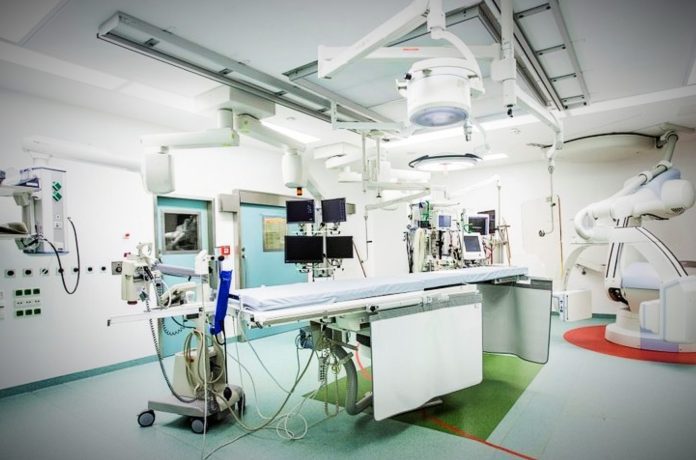As well as a new private 5G deployment in Hamburg for IT service provider Dataport, covered Wednesday (March 30), O2 Telefónica has confirmed a private 5G setup at the Helios Park-Klinikum, a private psychiatric and orthopedics hospital, in Leipzig. O2 Telefónica led the installation, with network equipment from Chinese vendor Huawei and build-phase support from German engineering services firm Iconec. Helios is managing the network.
The Leipzig install is the focus of the local ‘5G_eHealthSax’ research project, funded by the German government. Helios was the first clinic in Germany to receive a ‘vertical’ spectrum license from the Federal Network Agency (BNetzA), in 2020, for the site, in order to set up an independent 5G network. The network was actually switched on in December 2021; it is unclear from the press note whether the ‘news’ is to reveal details of the project, belatedly, or to announce new applications (positioning), or some O2 Telefónica extension to the existing 5G network.
The first and second of these alternatives are most likely. O2 Telefónica said ‘the network’ took four months to design, build, and activate – by O2 Telefónica. Construction was difficult, it said, on the grounds hospital operations could not be disrupted, and because of “electromagnetic compatibility” – to ensure network signals did not disrupt hospital equipment. O2 Telefónica “successfully carried out extensive EMC tests”, it said.
The Helios setup uses a “complete” standalone 5G core, with all components located on site. “This ensures data does not leave the premises and that only Helios, as the on-site campus network operator, has sole access and thus complete control over the network and network traffic. The radio network supplies around 50 premises spread over two buildings,” said O2 Telefónica.
“Special requirements must be taken into account – sensitive data is at stake, [as well as] people’s health and lives. Secure and reliable information exchange is a vital prerequisite, and the starting point for efficient treatment… 5G offers hospitals the best conditions for this. [its] ability to adapt optimally to new networking requirements is seen as a key to the success of digitization for modern healthcare facilities.”
The new network, described as a “digitalization turbo… [to] boost in efficiency and innovation”, goes over the top of existing wired (Wi-Fi) and wireless (public cellular) infrastructure, where the wireless local-area network (LAN) extension is for patients to access the internet, plus some hospital admin, and all the “vast majority” of hospital machines and services “run statically wired”. The 5G network is to replace these functional connections.
The newest ‘news’ in the press note, apparently, is about the use of 5G-based IoT positioning in the Helios wards. O2 Telefónica said: “An application was installed as edge computing that evaluates and visualizes the 5G positioning data via an algorithm… This is the first time [this]… has been tested in detail in a real 5G campus installation.” Tests have achieved positioning accuracy of about 10 centimeters – “under certain conditions”.
O2 Telefónica said: “Helios can point to an initial development success that can play a pioneering role in the industry. In coordination with medical departments, further development is now being defined and prioritized in order to be able to use the full benefits and further advantages of the installed 5G technology optimally for improvements in the e-health sector. With the availability of the platform, Helios has laid the foundations for this.”
The operator also outlined a future scenario, where hospital beds are (private) 5G-connected, on the grounds they are an “important collection point for vital data, medical records, information from devices next to the bed”. It said: “This all belongs to the bed and the patient, and should not be transmitted over insecure networks. At the same time, the bed is mobile. If it is moved, a lot of data is disconnected and the patient cannot be monitored during that time.”
It noted other hospital applications of 5G. Hospital wards can be more easily reorganised with 5G-connected equipment and machines, such as during Covid-19 style emergencies where departments were appropriated as ICU wards; manual drip feeds can be automated, also, in a modern infusion system – “controlled and monitored via the 5G campus network”.
Mallik Rao, chief technology and information officer at O2 Telefónica, commented: “We have set up our own 5G network with our technology partners, in which Helios can now test the practical application of the transmission technology in the hospital environment and everyday life… With the launch… many new applications will develop at great speed.”
Julian Zimmer and Matthias Hirsekorn, hospital directors at the Helios hospital site in Leipzig, said in a joint statement: “The aim is to optimize the efficiency of existing medical systems and to give doctors and nurses more time for core tasks. Thanks to the 5G infrastructure, our on-site employees will develop new ideas for what they can use the forward-looking campus network for. This will provide a qualitative boost for our services.”

